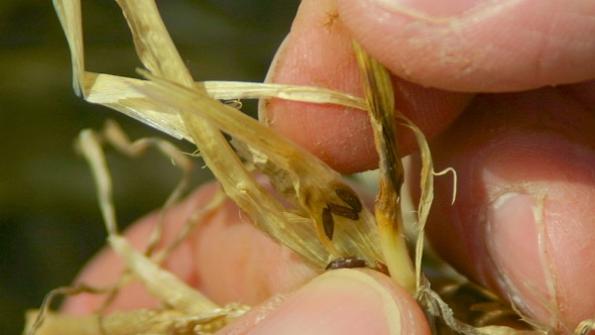
Hessian fly infestations have been found in southwestern Oklahoma winter wheat this fall, making it important for producers to identify affected fields and strategies that can assist in managing the pest next year.
“Even though there is not a 100 percent effective solution in terms of managing Hessian fly, producers have several options available to minimize the problems caused by this pest,” said Tom Royer, Oklahoma State University Cooperative Extension integrated pest management coordinator. “It starts with awareness about the pest and detecting its presence.”
Hessian fly infestations are often overlooked in wheat until damage becomes visible. The fly is tiny, only an eighth of an inch in size, and resembles a gnat. The larva does the damage to wheat, and starts out as an orange, headless and legless maggot that quickly crawls to a hidden feeding site in the plant.
“Once it attaches to the plant, it turns into a shiny, green-white maggot that doesn’t move until it emerges as a fly,” said Kristopher Giles, a research entomologist and professor with OSU’s Division of Agricultural Sciences and Natural Resources.
The mature larva forms a dark brown, eighth-inch-long puparium—a hard barrel-shaped case enclosing the pupae and commonly referred to as a flaxseed. The flaxseed serves as the over-wintering and over-summering stage.
TWO GENERATIONS
“We normally see two main generations in Oklahoma – in the fall and spring – plus several other pulses or minor infestations that can occur anytime during the winter when temperatures exceed 55 degrees Fahrenheit, coupled with a rainfall event of a half-inch or more,” Giles said.
Larvae injure the wheat as they feed, in the fall by feeding on stem tissue at the crown of young plants or by feeding just above the nodes of jointed wheat in the spring.
In the fall, young infested plants become dark-green to bluish-green in color and are stunted with thickened leaves. The infested tiller eventually dies. Some wheat varieties may compensate by producing more secondary tillers. Others have some level of genetic resistance.
“OSU’s Wheat Improvement Team screens most of the newly released varieties for Hessian fly resistance, so producers now have access to high-yielding forage or grain varieties that are resistant or partially resistant,” Royer said.
CONFIRMATION
To confirm a fall infestation, remove the plant and roots from the soil and inspect the crowns for maggots or flaxseeds by gently pulling the leaf sheath away from the stem. In spring, inspect the first or second joint of the stem inside the leaf sheath.
“You can estimate damage by counting fallen tillers per foot of row in several locations, and dividing that by the number of heads in a foot of row,” Royer said. “If you suspect that you have an infestation, bring the suspect samples in to your OSU Cooperative Extension county office for confirmation.”
Hessian fly outbreaks can be managed using several methods that work best when employed as part of a long-term management strategy.
Grow resistant varieties
Resistant varieties can be a very effective tool for managing Hessian fly. Entomologists with the OSU Wheat Improvement Team have been evaluating varieties for resistance and tolerance to Hessian fly for more than eight years.
Royer said resistant or partially resistant varieties include Duster, Gallagher, Everest, CJ, Centerfield, Ruby Lee (nearly resistant), Chisholm, Hatcher and 2174 (partially resistant).
“Producers who grow continuous wheat under no- or low-till management systems and who plan to plant in late September or early October, as well as producers planting clean-till in fields located near no-till fields, should strongly consider a resistant variety,” he said.
Plant late
Fields planted later, in mid- to late October, are at less risk of a fall infestation. A specific “fly-free planting date” does not exist for Oklahoma growers, with the exception of the northern tier of counties in Oklahoma, which includes the panhandle.
“A graduate student, Nathan Bradford, recently completed a survey of Hessian fly emergence using pheromone traps, and found that Oklahoma experiences extended emergence well past any alleged fly-free date for planting,” Giles said. “Still, a late planting should escape early emerging fly infestations and can be expected to improve the effectiveness of an insecticide seed treatment.”
Control volunteer wheat
Volunteer wheat serves as an early source for Hessian fly. OSU entomologists recommend growers destroy any volunteer wheat by Aug. 15 to reduce that reservoir.
Rotate wheat with a non-host crop
Crop rotation can be effective at reducing Hessian fly infestations. However, it is important to remember that Hessian fly adults can fly up to a mile from their over-summering/over-wintering site. Fields located next to continuous, no-till wheat fields are at greater risk from spillover infestations.
Bury wheat residue and control volunteer wheat
Hessian fly infestations are reduced when residue is buried 2 to 4 inches beneath the soil surface because the flaxseed is buried deep enough to prevent the fly from reaching the surface.
“This option is not available if the producer is committed to no-till,” Royer said. “No-till producers should use resistant varieties, multi-crop rotations, delayed planting and volunteer wheat control; also, seriously consider using an insecticide seed treatment.”
Speaking of which…
Consider using an insecticide seed treatment
As a last resort, seed can be treated with clothianidin, imidacloprid or thiamethoxam insecticide. They will reduce fall infestations if the rate is adequate and the wheat is not planted too early.
“Wheat planted in early September may suffer higher infestations even with treated seed because the insecticide becomes diluted within the plant as the wheat matures,” Royer said. “A late flush of Hessian flies in the fall will survive on treated wheat if planted much earlier.”
Royer and Giles stress it is important to remember insecticide seed treatments do not reduce spring infestations and will not eliminate an infestation, only suppress it.
Additional information about Hessian fly management is available online at http://osufacts.okstate.edu by consulting fact sheet EPP-7086, “Hessian Fly Management in Oklahoma Winter Wheat.”
About the Author(s)
You May Also Like




